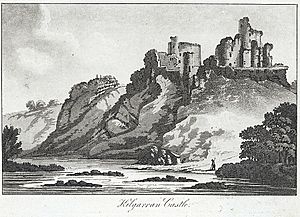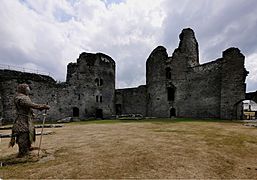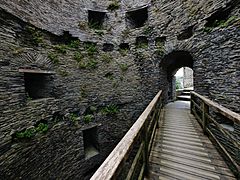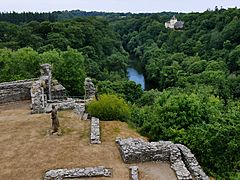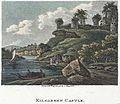Cilgerran Castle facts for kids
Cilgerran Castle (Welsh: Castell Cilgerran) is a ruined castle from the 13th century. It's located in Cilgerran, Pembrokeshire, Wales, close to Cardigan. The very first castle here was probably built by Gerald of Windsor around 1110–1115. Over the next hundred years, it was often fought over by English and Welsh forces.
The stone castle we see today started being built after 1223 by William Marshal, 2nd Earl of Pembroke. After belonging to several different families, it slowly fell into ruin. By 1400, it was completely abandoned. The castle is built right against a cliff. The parts that are still standing are from the 13th century. The strongest defenses faced inland, away from the cliff. These defenses include two large, round towers called drum towers, instead of a central main tower (a keep). The castle became a property of the National Trust in 1938 and is now open for visitors to explore.
What the Castle Looks Like
The castle sits on a high, rocky point of land called a promontory. It's right above the River Teifi. One side of the castle is directly on a cliff face. Before the stone castle, there was likely an older castle made of earth and wood. But Welsh forces destroyed that one.
The stone walls you see today were built around the 13th century. The walls facing the cliff were not as strong because the cliff itself was a good defense. Most of the defenses were focused on the side facing inland. This part had two lines of protection. There was an outer area (called an outer bailey) and two big, round drum towers. These towers were used instead of a single central tower, which was common in other castles back then.
The main entrance, or gatehouse, is on the southeast side of the castle. Only parts of it remain today. There was also a deep ditch dug out of the rock around the castle. People think a special bridge used to swing across this ditch. Cilgerran Castle is the most northern castle in Pembrokeshire. It's like a twin to Cardigan Castle, which is about 3 miles (5 km) downstream on the other side of the river.
Most of the castle is now in ruins, but its two large towers are still standing tall. From the castle, you can take walks down to the River Teifi. The National Trust owns the castle. It is looked after by Cadw, which is the Welsh government's historic monuments agency. The castle is open to the public to visit.
Castle History
The first Cilgerran Castle was built by Gerald of Windsor around 1110–1115. It was mostly just a wooden fence (palisade) at first. Later, a stone outer wall was added before Rhys ap Gruffydd attacked in 1165. Rhys had just taken Cardigan Castle a few weeks earlier. When he captured Cilgerran Castle, he completely destroyed it. He then started rebuilding it using stone and lime mortar.
In 1204, William Marshal, 1st Earl of Pembroke, took the castle back for the English. He drove out Rhys's son, Maelgwn ap Rhys. Marshal tried to fix the castle, but his repairs weren't strong enough. In 1215, Llywelyn the Great captured it again after only one day of fighting.
William Marshal, 2nd Earl of Pembroke, took the castle back in 1223. He began rebuilding the castle into the strong stone fortress we see today. The de Cantilupe family later finished this work. The large size of the stones used in the remaining parts of the castle shows that it was built very quickly.
After this rebuilding, Welsh forces never captured Cilgerran again. However, in 1258, when English forces were defeated nearby, the castle had to fight off attacks from the Princes of Deheubarth. After Anselm Marshal, 6th Earl of Pembroke, died, the castle passed to the de Cantilupe family through a female heir. It changed hands again in 1272, going to the Hastings family.
But by 1387, Cilgerran Castle was allowed to fall into ruin. It was thought to be empty and abandoned by 1400. Even so, the property continued to be passed down through the Earls of Pembroke. It even belonged to Jasper Tudor, Duke of Bedford, for a time. In 1509, Gruffudd Vychan was named the person in charge of the Cilgerran area and the castle's commander.
Cilgerran Castle has been featured in several famous paintings. These include Kilgarran Castle on the Twyvey; Hazy Sunrise, previous to a Sultry Day, Cilgerran Castle on the Teifi, Looking Upstream, and View in Wales: Mountain Scene with Village and Castle – Evening. All of these were painted by J. M. W. Turner and are now in the national collection at the Tate gallery. In 1938, the castle was given to the National Trust.
- Cilgerran Castle
More Pictures



